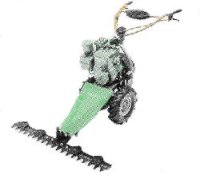Labour-saving technologies and practices: motorised single-axle mowers and reapers for harvesting cereals
The following explains the basic technical aspects of a motorised single-axle mower and a reaper. It also details their advantages and disadvantages.
Description
1. Features of motorized single-axle mowers and reapers
- Single-axle mowers and reapers generally range in power from around 1.5 kW to 10 kW.
- The operator usually walks behind them, although some have a "sulky" style trailed seat on two wheels.
- Crops suitable for harvesting by these machines include rice, wheat, and barley.
- Hay or grass mowers are available with cutter bars or rotary cutters.
- Reapers also have cutter bars, are generally designed for row crops and usually have mechanisms for stacking the crop.
- The work rates of mowers and reapers are substantially higher than hand reaping.
- For example, a 2.2 kW reaper harvests rice at a rate of 2.4 hectares per day.
2. Advantages
- Labour-saving
- Higher work rates compared to manual harvesting.
- It allows for overcoming manpower shortages and undertake harvests in less time.
- Livelihood resilience strengthening
- Suitable for small farmers and small plots.
- This equipment allows harvesting the crop at optimum dates, so it can be in the market with optimum quality and in proper time.
- Livelihood diversification
- Opportunity to offer farm power hires services to others.
- Equipment
- Most mowers and reapers are based on power tiller units, which make them very versatile implements when all the attachments are available.
3. Disadvantages
- Equipment
- Relatively complex.
- Cost and risk
- The high cost of purchasing and running machinery compared to manual harvesting tools, and risk associated with financial investment.
- Skills
- Required for the efficient and safe operation of machinery.
- Risk
- May fail if introduce hire services into an area where there is insufficient demand to pay for contractual services.
- Infrastructure
- Considerable infrastructure support required for their efficient operation.
Figure 1. Mower

©FAO/TECA
5. Related/associated technologies
- Labour-saving technologies and practices: manual and motorised cleaning of grains and pulses: ID 7310.
- Labour-saving technologies and practices: pack animals and animal drawn carts: ID 7311.
- Labour-saving technologies and practices: manual and motorised threshers: ID 7313.
- Labour-saving technologies and practices: improved hand tools for harvesting cereals: ID 7295.
6. Objectives fulfilled by the project
6.1 Labour-saving technology (LST)
The practice decreases manpower shortages and undertakes harvests in less time.
6.2 Pro-poor technology
The practice leads to higher work rates compared to manual harvesting. It also strengthens livelihood resilience.
Author: Rural Infrastructure and Agro-industries Division (Agricultural Machinery and Infrastructure) AGS in FAO
Organization: The Food and Agriculture Organization of the United Nations FAO TECA
Year: 2020
Type: Practices
Full text available at: https://www.fao.org/teca/en/technologies/7314
Content language: English
